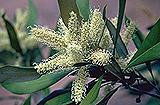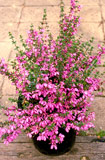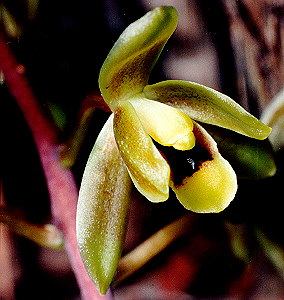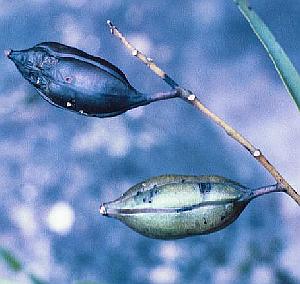|
[Front Page] [Features] [Departments] [Society Home] [Subscribe]

Short Cuts
Short items of interest about Australian plants selected from the many newsletters and journals published by member Societies of ASGAP.......
Short Cuts in this issue:
 Spectacular Foliage from the Tropical North Spectacular Foliage from the Tropical North- The many attractions of north Queensland's Grevillea baileyana.
 Why grow native plants in pots anyway? Why grow native plants in pots anyway?- There are lots of reasons but...do you really need one??
 Growing Orchids from Seed Growing Orchids from Seed- It might not be as difficult as you think!
 The Three "R"s of Garden Design The Three "R"s of Garden Design- Looking for key factors which should be given consideration in garden design.
 Propagating from Cuttings Propagating from Cuttings- A few tricks to help improve your success rate!!
 Magic Moments...... Magic Moments......- Sometimes the unexpected events in the garden are the most pleasant

Spectacular Foliage from the Tropical North
Grevillea baileyana has much to offer growers of Australian plants - spectacular flowers and attractive foliage make this a plant that should see wider cultivation. Rhys McGregor has the full story.....
The rainforest flora of northern Australia has become more readily known and available to the horticultural industry in recent years. This flora offers a diversity of both foliage and flowers which, as yet, has been only used sparingly by the horticultural industry. The Protea family (Proteaceae) contains many species which are well suited for commercial development. One of the most stunning members of this family is "Findley's Silky Oak", or Grevillea baileyana.
This tree, to 25m in height, occurs naturally in tropical rainforest from Tully, Queensland spreading north into New Guinea. In cultivation it rarely exceeds 6-10 metres. This tree grows rapidly in plantation, growing successfully along the east coast as far south as Melbourne.
The tree has two stunning features: the foliage and the spectacular summer flowering spikes.
Like many of the rainforest Proteaceae, the foliage has two distinct forms. The juvenile leaves are large and lobed, up to 50cm in length. The young foliage is deeply lobed with from 3 to 9 rectangular or tapering lobes, up to 15cm, forming the entire leaf. The mature leaves are usually entire or oval shaped. These are up to 20cm in length. The most outstanding feature of this plant is the foliage. The upper surface is a deep, glossy green with the undersurface a lustrous rich golden bronze. The foliage creates a colourful display and the cut foliage is stunning in a vase, or as the backing for a floral arrangement. The leaves dry without losing their colour and have a long vase life. The Iron Range form is more spectacular with a larger and more deeply lobed foliage.
 |
The massed flower clusters of Grevillea baileyana make a spectacular sight.
Select the thumbnail image or highlighted name for a higher resolution image (35k). Photo: Keith Townsend
|
During late spring and into early summer long, lacy cream coloured flower spikes cover the tree. The flower spikes are borne terminally in branching panicles. Each raceme is up to 15cm long with as many as 10-12 spikes occurring together.
G.baileyana is long lived and establishes readily in a wide range of coastal and near coastal climates. In cultivation it tends to branch from the base forming a tall shrubby habit. It requires little maintenance, except for summer watering during dry periods, although exposure to excessive winds may cause damage to the foliage.
The juvenile foliage can be prolonged by pruning the branches. It is tolerant of mild frost.
G.baileyana has great potential for the horticultural industry with its luxuriant, attractive lobed juvenile foliage and long stem life. The flower spikes are another potential summer flower crop.
This is one of the best rainforest trees, growing well in both tropical and temperate regions of Australia.
From the newsletter of the Grevillea Study Group, October 1996.
[ Return to Index
]

Why grow native plants in pots anyway?
You don't just have to have a "lack of space" problem to grow plants in containers. Lorna George thinks that there are lots of other reasons.....
The question is sometimes posed - why try to grow native plants in pots? They are often hard enough to grow in our gardens, despite all our tender loving care. Is there anything special about growing a native plant in a pot as against a well-proven exotic? As I see it, both have their place and many plants in pots people rejoice in a flourishing pot of either kind.
However, you may be interested to ponder the following reasons often advanced for growing native plants in pots:

An attractive display of Australian plants
that would brighten any verandah or patio.
Photo Cherree Densley.
|
- There are many lovely native plants we would love to have growing, but our gardens cannot provide the conditions for a particular plant of our choice. In a container the right aspect, the right type of soil and the right drainage conditions may make it possible for the plant to flourish.
- Garden spaces are becoming smaller - we may not have the room to plant all the plants we would like to grow.
- For some, there is no garden space. If one lives in a flat or unit, the only way to grow any plant is in a container.
- Attractive pot plants can be used to enhance any verandah, porch or garden. Pot plants can be "portable gardens". They can be moved from place to place to suit the occasion or to be a valuable part of a garden design.
|
- Much is still to be learnt about growing native plants successfully in gardens or in pots. The more people grow and experiment with containers, potting mixes, plants, combinations of plants, the more knowledge is gained and can be disseminated. Native plants still have to prove their reliability as garden subjects for many and the more that is learnt about the needs of native plants in cultivation the more acceptable they will become.
 |
Tetratheca thymifolia makes a colourful display in a medium-sized container.
Select the thumbnail image or highlighted name for a higher resolution image (41k).
|
- Native plants species are being endangered as their habitats are destroyed. Their conservation may depend on people maintaining them in garden situations. Growing plants successfully in containers may be a valuable contribution to this cause.
- Do you enjoy a challenge? Growing and maintaining plants in containers is both a rewarding and a frustrating business. It does take time and care, but a flourishing native plant in a pot is a very satisfying achievement.
From the newsletter of the Central Coast Group of the Australian Plants Society (NSW) via "Native Plants for New South Wales", July 2000.
[ Return to Index ]

Growing Orchids from Seed
Growing orchids from seed is often regarded as being beyond the capability of the average, amateur grower. John Moye wants to dispel that myth!
For those of you who like to try out different techniques of plant propagation, and have access to orchid seed, the following method of growing orchids from seed, might be appealing. Some of the spring flowering orchids, especially the epiphytic species, might be pollinated by visiting insects and go on to produce seeds. Others can be induced to produce seeds by transferring the pollen from one flower and depositing it on the stigmatic surface of another, using a tooth pick or something similar. Once pollinated, most flowers produce pods in due course, most containing many hundreds (or thousands) of seeds. Collect these as the capsules commence dehiscing (releasing the seed). Then try the following technique.


|
- Line the inside walls of a new, or clean, plastic pot about three parts of the way up with cloth (cotton tea towel or old singlet). This cloth is to act as a water wick. Use 10 to 15 cm. diameter squat pots.
- Fill the pot to almost the top of the cloth with washed crushed metal or stones (up to 1 cm in size).
- Boil about a cupful of sphagnum moss and place sparsely over the stones (use green sphagnum if available) The boiling of the moss is to kill it, otherwise it will grow and choke the small orchid seedlings.
- Pour a jug of boiling water over the moss, metal and pot and allow to cool.
- Place a few small pieces of live roots (about 4 cm in length), for preference from the pod parent, towards one side of the pot, then sow the seed - place a little seed on a creased piece of paper and spread as you would salt on your food.
- Cover the pot with clear plastic and tie by using soft copper wire or perhaps an elastic garter. Then cover this with a black plastic and tie in a similar fashion.
|
Cymbidium suave
Flower (top). Photo - Greg Steenbeeke, Orchids of North Eastern NSW
Seed capsules (bottom). Photo - Brian Walters
|
- After about 14 days, remove the black plastic Then carefully lift the side of the clear plastic to remove the roots (use tweezers or similar) Visible germination should occur in about four to six weeks from sowing, but will vary depending on the seed sown and the time of the year.
- Watering is done by standing the pot in an ice cream container filled with water (rain water preferred) up to about 2 cm from the top of the cloth for a short time. Try to avoid letting the sphagnum dry out too much, but don't over water either.
- Pots should be left covered with the clear plastic until the seedlings have reached 1-2 cm in height. They can then be removed and put into small orchid pots filled with a suitable orchid potting mix and treated as small plants until ready to transfer into larger pots, or onto trees or rocks, around your home.
For best results, keep pots out of direct sunlight at all times. 1 have found that by placing pots under top benches in a shade house is ideal, although many others keep pots in a well-lit room indoors. Also, try to place pots in an area experiencing fairly uniform temperature conditions, at least during the early growth stages. Lastly, avoid lifting the plastic to see how things are going. By so doing, the potential for unwanted bacteria, spores,etc. contaminating the developing plants is increased. While this technique, at first appears messy, it really is quite simple and straightforward and the results certainly justify the effort made.
Good Luck.
From the newsletter of the Far North Coast Group of the Australian Plants Society (NSW), October 1999.
[ Return to Index
]

The 3 "R"s of Garden Design
What makes one native garden more aesthetically appealing than another. Diana Snape suggests that there are there are three important elements.
I was wondering recently whether it was possible to generalise about key factors which should be given consideration in garden design, and came up with these three "R 's They aren't necessarily factors which spring immediately to mind. How important or how universal do you think they are?
1. Ratios (or proportions)
A number of ratios determine the feeling of balance or equilibrium in the garden. This balance may feature symmetry, asymmetry, or both and needs to be aesthetically pleasing (or balanced) to the garden owner and ideally to others. Among the many different ratios I think need to be considered are the following:
- Open space at around level, including widths of paths and areas of very low growth groundcover plants, compared with garden beds or planted areas.
- Open space (or 'void') and mass in 3 dimensions, at shrub and tree height, so the garden does not feel too crowded. In both this ratio and the first I think it is easier to end up with too little open space rather than too much.
- Heights of plants - trees, shrubs, groundcovers, tufted plants. The proportions or ratios of the heights of these plant types, and the numbers of each used, will obviously have a big effect on the nature of the garden.
- Comparative sizes of plants which are related in the design, for example is this plant the right size for this rock? Is the tufted grass at its base too big or too small for this tree? Is the size of this 'frame' appropriate for the vista it encloses? All these depend on ratios of sizes, or proportions, and your personal response to them. What each plant is, is relatively unimportant!
2. Repetition (and restraint)
'Collectors' may relish variety but I think variety has distinct dangers and restraint its merits To me it is rare for a garden to be satisfying without at least a minimum of repetition in some aspect of its character This could be its vegetation or its themes (or both). Some possibilities for repetition are:
- Actual species of plants, as occurs so frequently in nature, providing a harmonious framework. These can be interspersed with other species - just a few others or a variety; at any one time only one or two species will probably be visually dominant. One area can merge into another with a 'drift' of one of the dominant or lesser plants. These could be any size from trees to just simple groundcovers.
- A particular genus of plants, with the special interest of the similarities but differences within a genus. Some additional repetition of certain species of that genus could improve the continuity.
- Similar foliage, giving a sense of cohesion (for example repetition of callistemons, or of ferns). Leaf size might well vary more than leaf colour and a little contrast would emphasize the closer resemblance of most of the plants.
- Similar forms, e.g. slightly formal rounded or arching forms, or tall upright shapes, again with a little contrast to balance the repetition and avoid too much of a good thing.
- Colour, creating a colour scheme of flowers (also buds, berries, fruits, etc). An enormous variety of colour schemes are possible to link plants visually - a separate subject all on its own.
3. Rest areas
It's too easy to think of our garden as a place where we work. We do, of course, but it's very important to enjoy the fruits of our labours, for which I think we need to have rest areas. This understanding has only come to me quite recently! Often we might walk too quickly through the garden without fully enjoying its beauty.
These rest areas can be considered in two ways:
- Visually, rest areas can be 'quiet' areas in the garden to look out at from inside the house, or to enjoy when you're in the garden - restful to look at, not 'busy' with too much variety in the plants or special features. They can be sheltered areas to pause in while strolling (going 'walkabout') in the garden - you shouldn't feel you have to keep moving on.
- Physically, there must be somewhere to actually sit down and have a 'cuppa' in the garden. This means a comfortable sitting down spot - a seat, a stone wall, a log or a rock. Ideally this spot will need some open space so it's not totally enclosed and you can admire your handiwork, but it will be partly sheltered or screened so it's not totally exposed either. If possible, a curved seat rather than a straight one, with adjacent rounded beds or planted areas somehow seems cosier.
So, trying to approach design from slightly different angles to the usual, I'd suggest ratios, repetition and rest areas as three key design "R"s.
From the newsletter of the Garden Design Study Group, May 1998.
[ Return to Index ]

Propagating from Cuttings
"How do I propagate Australian plants from cuttings??" Kevin Handreck replies to this question which appeared in an SGAP newsletter.
For the detail of this answer, I will rely on some information provided by Dawson and King in The Australian Journal of Experimental Agriculture (Vol. 34, pages I225-1231, 1994). They studied the effect of a number of rooting hormone preparations and bottom heat temperatures on the rooting of the following species: Astartea fasicularis, Chamelaucium uncinatum cv Purple Pride, Crowea exalata, Hardenbergia violacea, Pimelea ferruginea, P rosea, Prostanthera cuneata and nine verticordias. They had very poor results with the commonly available, talc-based hormone preparations. Best results were obtained with a solution of indole-3-butyric acid (IBA) in alcohol (ethanol, as in brandy, etc.).
Their method is as follows: Cuttings 4-10 cm long were taken from actively growing tips, with the cut made either in the actively elongating soft, new tissue (softwood) or between this zone and the point at which the wood was hardening (semi-hardwood). Leaves were removed from the lower half of each cutting, although the authors stated that this was not really necessary with Chamelaucium uncinatum. Leaves were left intact where their removal caused epidermal layers of the stem to tear away.
The optimum treatment was to dip the bottom 2 cm of stem for 40) seconds into a solution of 4 grams of IBA per litre of alcohol (Use a timer or count the seconds - don't guess! My experience with this method is that a 40 second dip can kill the lower part of some cuttings. If this happens with some of your cuttings, try shorter dipping times). Excess alcohol is shaken off and the cutting inverted to allow the remaining alcohol to evaporate for about 30 seconds before planting. The propagation medium used by Dawson and King was equal parts of New Zealand peat, perlite (P500) and vermiculite (Grade 3), but probably many other mixtures would work just as well.
Dawson and King used misting and bottom heat. The home equivalent of misting is to enclose the cuttings in a plastic bag or in a broccoli box topped with plastic sheeting or a pane of glass. The cuttings can be misted with rain water up to several times each day. Shading should be to half of daylight. Bottom heat can be provided by one of the small heater mats that can be purchased from nursery outlets, or by the heaters that are used by home-brew makers. The optimum temperature range for the rooting medium is 22-30oC. Be pleased if you average a strike rate of 50%.

IBA can be purchased via credit card from Sigma Chemicals Co by ringing (toll-free) 008 800 097. Their catalogue number is 15386. The price is $12.70 for 1 gram, $38.10 for 5 grams and $101.50 for 25 grams. Delivery is $15.00 per order. Do not buy the potassium salt of IBA.
Light causes IBA solutions to deteriorate. Those interested in making up their own solution could buy 1 gram of IBA and dissolve it in 250 mL of methylated spirits. Most of the solution should be stored in a freezer in 50-l00 mL polyethylene bottles, with one bottle for immediate use being kept in the refrigerator. For dipping, pour some to a depth of 2 cm into a glass or polythene vessel of small diameter. This will minimise the amount of liquid that has to be used on each occasion. The partly-used liquid should be discarded at the end of a cutting-preparation session, as chemicals that could inhibit root formation may have been dissolved from the cuttings by the alcohol.
A preparation of just the right strength, called Rootex-L is available in garden centres. Its strength may or may not be as stated, as there is no way of knowing how long It has been sitting on the shelves at the garden centre, wholesaler or factory.
From the newsletter of the Australian Plants Society (South Australia), August 1996
[ Return to Index ]

Magic Moments........
It's not often that watching a favourite plant being (almost) decimated can be regarded as a "magic moment"! But, as Jeanette Closs discovered, sometimes it's satisfying to just let nature take its course.
On a lovely sunny winter's day early in July, I was quietly weeding in our garden, when a large noisy bird landed in a Banksia marginata plant nearby. Much to my surprise it was a Yellow-tailed Black Cockatoo. My banksia is only about 1.3 metres high and it was only about 2 metres from where I was standing, so l had a very good view of my visitor. He proceeded to pick off a mature banksia cone and, holding it in one claw, he nibbled off the seeds, at the same time calling to his mates in a nearby tree. In no time at all others realized that there was a potential banquet on hand and two other Black Cockatoos joined their friend.

|
|
For the next fifteen minutes I stood quite still leaning against the back wall of the house watching these three thieving fellows take one cone after another and strip it of seeds, then drop it on the ground. The first one preferred to remain on the branch to consume his goodies, but the other two took their treats to the ground nearby. One of the ground-eating birds emitted a squawking sort of a growl as he ate, but the other two were more polite and the only noise was the cracking sound of the seeds being extracted. As the plant is only a small one, the branches are not robust and holding the weight of these large feathered creatures put much strain on the limbs. And a couple of times a cockatoo did a complete somersault as the branch dipped unexpectedly.
|
Yellow-tailed Black Cockatoo on Banksia spinulosa
Photo: Birds Downunder.
|
Twice during this spectacle there was an angry confrontation presumably over a choice seed-cone and the brief squabble that ensued sounded like two cats fighting. I was feeling rather tired standing so still for fifteen minutes, that I slowly edged around the corner of the house. There was a seat in the sun and here I sat enjoying this tableau, and also the supporting acts of a couple of Brush Wattlebirds sipping nectar from a Grevillea 'Moonlight' which grows alongside the Banksia and an Eastern Spinebill doing likewise in a nearby Grevillea 'Austraflora Canterbury Gold'.
The only other time that I remember watching these incredible cockatoos dining, was in banksias on the shores of Lake Dove last November, when walking with some of our family.
This was an unexpected bonus to the joys of a good Australian native garden and its many faunal visitors. I thought it was a unique experience until I found that these birds have visited many other people in our area.
From "Eucryphia", the newsletter of the Australian Plants Society (Tasmania), October 2000.

[Front Page] [Features] [Departments] [Society Home] [Subscribe]
Australian Plants online - December 2000
Association of Societies for Growing Australian Plants
|